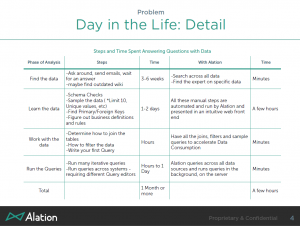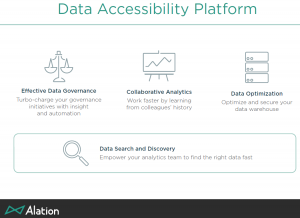I’ll start by being very clear: This is a slam on bad marketing. Do not take this column as a statement that the products have problems, as we didn’t see the products.
Database Trends and Application magazine/website held a webinar. The first clue there was something wrong is that an hour long seminar had three sponsors. In a roundtable forum, that could work, and the email mentioned it was a roundtable, but it wasn’t. Three companies, three sequential presentations. No roundtable.
It was titled “The Future of Big Data: Hybrid Architectures and Best-of-Breed”. The presenters were Reiner Kappenberger, Global Product Manager, HP Security Voltage, Emma McGrattan, SVP Engineering, Actian, and Ron Huizenga, ER/Studio Product Manager, Embarcadero. They are three interesting companies, but how would the presentations fit together?
They didn’t.
Each presenter had a few minutes to slam through a pitch, which they did with varying speeds and content. There was nothing tying them into a unified vision or strategy. That they all mentioned big data wasn’t enough and neither was the time allotted to hear significant value from any of them.
I’ll burn through each as the stand-alone presentations they were.
HP Security Voltage
Reiner Kappenberger talked about his company’s acquisition by HP earlier this year and the major renaming from Voltage Security to HP Security Voltage (yes, “major” was used tongue-in-cheek). Humor aside, this is an important acquisition for HP to fill out its portfolio.
Data security is a critical issue. Mr. Kappenberger gave a quick overview of the many levels of security needed, from disk encryption up to authentication management. The main feature focus on Reiner’s allotted time is partial tokenization, being able to encrypt parts of a full data field. For instance, disguising the first five digits of a US Social Security number while leaving the last four visible. While he also mentioned tying into Hadoop to track and encrypt data across clusters, time didn’t permit any details. For those using Hadoop for critical data, you need to find out more.
The case studies presented included a car company’s use of both live, Internet of Things feeds and recall tracking but, again, there just wasn’t enough time.
Actian
The next vendor was Actian, an analytics and business intelligence (BI) player based on Hadoop. Emma McGrattan felt rushed by the time limit and her presentation showed that. It would have been better to slow down and cover a little less. Or, well, more.
For all the verbage it was almost all fluff. “Disruption” was in the first couple of sentences. “The best,” “the fastest,” “the most,” and similar unsubstantiated phrases flowed like water. She showed an Actian built graph with product maturity and Hadoop strength on the two axis and, as if by magic, the only company in the upper right was Actian.
Unlike the presentations before and after hers, Ms. McGrattan’s was a pure sales pitch and did nothing to set a context. My understanding, from other places, is that Actian has a good product that people interested in Hadoop should evaluate, but seeing this presentation was too little said in too little time with too many words.
In Q&A, Emma McGrattan also made what I think is a mistake, one that I’ve heard many BI companies get away from in the last few years. An attendee asked about biggest concern when transitioning from EDW to Hadoop. The real response should be that Hadoop doesn’t replace the EDW. Hadoop extends the information architecture, it can even be used to put an EDW on open source, but EDWs and big data analytics typically have two different purposes. EDWs are for clean, trusted data that’s not as volatile, while big data is typically transaction oriented information that needs to be cleaned, analyzed and aggregated before it’s useful in and EDW. They are two tools in the BI toolbox. Unfortunately, Ms. McGrattan accepted the premise.
Embarcadero
Mr. Huizenga, from Embarcadero, referred to evidence that the amount of data captured in business is doubling every 1.2 years and how the number of related jobs is also exploding. However, where most big data and Hadoop vendors would then talk about their technologies manipulating and analyzing the data, he started with a bigger issue: How do you begin to understand and model the information? After all, schema-on-write still means you need to understand the information enough to create schemas.
That led to a very smooth shift to a discussion about the concept of modeling to Embarcadero. They’ve added native support for Hive and MongoDB, they can detect embedded objects in those schemas and they can visually translate the Hadoop information into forms that enterprise IT folks are used to seeing, can understand and can add to their overall architecture models.
Big data doesn’t exist in a void, to be successful it must be integrated fully into the enterprise information architecture. For those folks already using ERwin and those who understand the need to document modeling, they are a tool that should be investigated for the world of Hadoop.
Summary
Three good companies were crammed into a tiny time slot with differing success. The title of the seminar suggested a tie that was stronger than was there. The makings existed for three good webinars, and I wish DBTA had done that. The three firms and the host could have communicated to create an overall message that integrated the three solutions, but they didn’t.
If you didn’t see the presentation, don’t bother. Whichever company interests you check it out. All three are interesting though it might have been hard to tell from this webinar.

